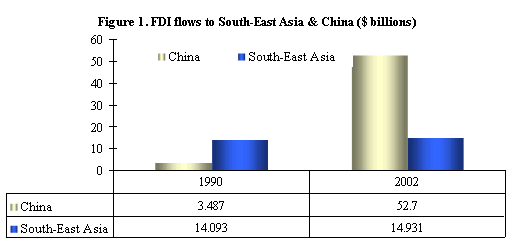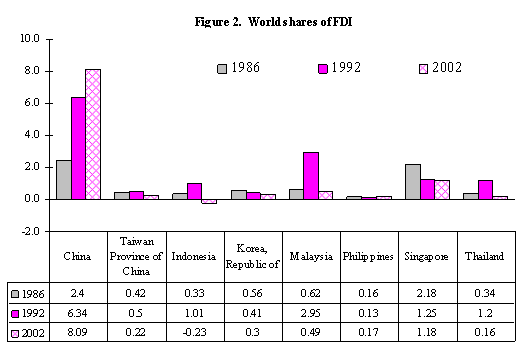China´s burgeoning exports worry some policy makers in neighbouring East and South-East Asian countries, but it is not just exports they are keeping an eye on. It is also the attractiveness of China to foreign direct investment (FDI), which most of these countries depend on for industrial and export growth and which China is drawing in massively. A forthcoming article in the April issue of UNCTAD´s Transnational Corporations journal nonetheless argues that their fears are misplaced, and that China is not in fact depriving them of FDI (1). On the contrary, it is helping them attract more FDI in the integrated production networks that handle most of their technology-based exports, maintain the authors, Professor Sanjaya Lall of Oxford University and Associate Professor Yuping Zhou of Wuhan University of Technology. China´s efficient manufacturing base is strengthening rather than weakening their own production, allowing them to specialize in different segments of the value chain. The countries most likely to be negatively affected are outside the region - namely, the industrialized countries and aspiring exporters in other developing regions.
FDI to China in 2002 was 28 times higher than in 1986, and its share of global FDI inflows rose from 1.4% to 8.1% over the same period. In 1990, the other countries of South-East Asia attracted four times as much FDI as China; by 2002, that situation was reversed (figures 1 and 2). In 2003, China overtook the US as a destination for FDI and, with inflows of $53 billion, became the largest FDI recipient in the world (excluding Luxembourg).
Given the size of the Chinese market, its explosive growth, low labour costs and razor-edged export competitiveness, it is likely to keep on attracting massive investment inflows into both domestic and export market-oriented activities, the authors say. But will it suck FDI away from neighbouring countries?
The authors conducted an econometric analysis to assess whether China´s FDI growth has affected inflows into seven East Asian "tiger" economies. It suggests that once other determinants of FDI are taken into account, China has no significant effect on inflows to other East Asian countries. In fact, during 1992-2001, China´s FDI was positively related to FDI in other countries. This would indicate that most FDI flows do not compete with each other, and that for potentially competitive (export-oriented) FDI, China is encouraging investment in other countries as a complement to its role within Asian production networks. Thus, the Asian giant appears to be crowding in rather than crowding out FDI in the region.
The article seeks to explain this finding. Transnational corporations (TNCs) can easily find resources if they see a good investment opportunity, suggesting that the supply of FDI (investible resources) to East Asia is flexible. Currently, FDI forms only 12% of global capital formation, and the East Asian region, including China, accounted for 16% of global inward FDI flows between 1986 and 2002 (14% in 2002).
Furthermore, much of FDI in East Asia is geared to domestic markets (which will grow as services are liberalized) and resource extraction. China does not pose a threat to other countries here, as FDI inflows depend on each country´s growth prospects, resource base and investment climate.
Countries do, however, compete for FDI in export projects. The number of such projects is determined by the global market, and if a TNC puts an export-oriented plant into China it deprives some other prospective site of that plant.
The authors end on a note of caution. Not all export-oriented activities are organized in tight production chains where countries support each other, undertaking different functions. In low-tech activities like clothing or footwear, growing FDI in China is likely to crowd out investment in neighbouring countries. Even in the hi-tech activities where China is now complementing other nations, it may crowd them out in the future as it seeks to take larger shares of exports and high-value functions.
ANNEX
Tables and figures
Figure 1. FDI flows to South-East Asia & China ($ billions)
Source: UNCTAD, World Investment Report, various years, at www.unctad.org/wir . For purposes of this figure, "South-East Asia" comprises Taiwan Province of China, Indonesia, Republic of Korea, Malaysia, Philippines, Singapore and Thailand.
Figure 2. World shares of FDI
Source: UNCTAD, World Investment Report, various years, at www.unctad.org/wir .


